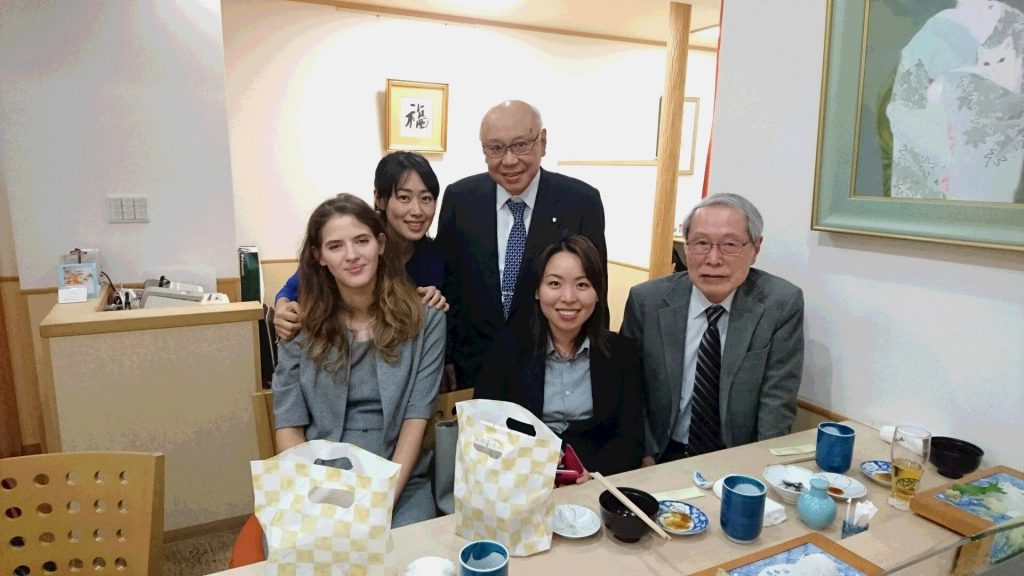As Ms. Vanda Máté and Ms. Rina Sembommatsu pointed out, they both had wonderful experiences in Japan. They were welcomed by the utmost kindness and hospitality at the dormitory as well as at the university and the hospitals during their practice. As they were the first Semmelweis students who participated in this exchange program, they had the privilege to have dinner with President Usui of Tokyo Medical University and Chairman Suzuki of the Board of Regents. Both students have made very good friends with Japanese students, who introduced Japanese culture to them, showed them around in Tokyo, even took them to see the less touristic places, and invited them for dinner with their friends. Both Semmelweis students speak highly of the professional experience that they received from this opportunity.

“Thanks to my direct supervisor, Dr. Akiko Teshima, I tried out CGM (continuous glucose monitoring) on myself, and observed the process of a continuous insuline pump/glucose sensor (sensor augment pump) patient education. My senior supervisor Dr. Tomono Takahashi, whose speciality is Diabetology, also taught me about the examination and treatment of DM (diabetes mellitus). Not only did she teach me, but she organised visits for me in both Scintigraphy (of suprarenal gland) and an operation with the famous DaVinci robot in Urology (prostatectomy). It was fascinating to see them both.”, said Ms. Vanda Máté about her experiences spent at the Department of Diabetes, Metabolism and Endocrinology.
“I was honoured to meet Professor Itoi, the Head of the department, who is a skillful gastroenterologist and an inventor himself. He invented a unique shield for radiation used at ERCP, and several endoscopic methods. He explained a lot about ERCP and all the procedures I saw, even when WBS Television was filming him about the procedure. You might have seen him on TV on the 31st of October. My supervisor was Assistant Professor Dr. Sugimoto, who honoured me by teaching me about his methods, and was always there to answer all my questions. During my gastroenterology training I saw gastroscopies, biopsies, EVS (endoscopic variceal sclerotherapy), liver ultrasound examinations (which I also practised with Dr.Maya Suguro) and contrast enhanced ultrasound , colonoscopies, ERCP (endoscopic retrogade cholangiopancreatography), MR fused ultrasound (which is cutting edge, high-end technology!). It was amazing to see where worldwide leading medicine is born, and learn from world-famous doctors. The most amazing phenomenon was their mentality: they were humble, kind and always willing to educate us.”, recalled Ms. Vanda Máté about the Department of Gastroenterology, where she spent the second two weeks.
Ms. Rina Sembommatsu had a fantastic opportunity to spend two weeks each at the Department of Gastroenterology and at the Department of Emergency and Critical Care Medicine.
“TMU is keen on non-invasive methods of diagnosis and treatment. For example, I observed a clinical trial of a high frequency ultrasound ablation of a pancreatic tumour, which is only performed at TMU. Additionally, Dr. Sugimoto explained to me about his research on a new non-invasive method to diagnose Non Alcoholic Steatohepatitis (NASH). Currently, the only way to diagnose NASH is through an invasive method of taking biopsy from the patient. A new technique of “Elastography,” a part of ultrasound, measures elasticity and viscosity of the liver. The higher the elasticity indicates fibrosis of the liver, depicting cirrhosis; while higher the viscosity indicates inflammation and necrosis. Hence, with hyperechoic image portraying fatty liver and higher levels of elasticity and viscosity, can diagnose NASH without a biopsy. This is extremely interesting because it is a brand-new concept.”, said Ms. Rina Sembommatsu about her professional experiences in Japan.
“With regards to Japanese hospital culture, I observed an enormous amount of respect between each other, between doctors and patients, between everyone. Such a respect is not necessarily prevalent in rest of the world. For Japanese people, respect is something that is obvious and effortless, but from my perspective, it is astounding. Due to this respectful culture, the patient compliance seems to be much higher in Japan than many other countries.”, highlighted Ms. Rina Sembommatsu.
In return, two Japanese students will spend a month at Semmelweis University in April 2018 in the framework of the student exchange program.
Source and photo: Rina Sembommatsu, Vanda Máté